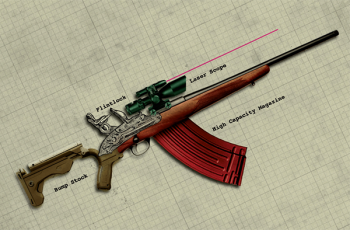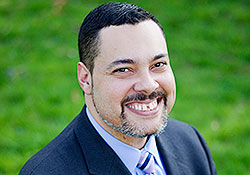Blocher and Miller compile comprehensive historical gun law database

Professors Joseph Blocher and Darrell Miller have spearheaded the creation of a comprehensive database of historic gun laws for use as a research tool for scholars, litigators, journalists, and others interested in current debates surrounding firearms regulation and the Second Amendment.
The searchable Repository of Historical Gun Laws compiles English statutes from the Middle Ages through 1776 and those in the United States from the Colonial era to the middle of the 20th century. To date, it includes 1,514 regulations, searchable by subject area, date range, and jurisdiction.
For Blocher and Miller, constitutional scholars who focus on the Second Amendment, the centrality of history to the Supreme Court’s foundational rulings in District of Columbia v. Heller and McDonald v. City of Chicago clarified the need for easily accessible information on historical gun regulation. In its 2008 Heller decision, the Court held that the Second Amendment protects an individual’s right to possess firearms for self-defense, not just for militia service. The Court subsequently held, in McDonald, that the right applies to the states as well as the federal government.
Both opinions relied heavily on history to understand the scope of the right to bear arms, said Miller, the Melvin G. Shimm Professor of Law. “In fact, Justice Scalia says in the Heller opinion that you understand the contours of the Second Amendment by reference to regulations that are longstanding.”
Writing for the Heller majority, the late Justice Antonin Scalia rooted weapons regulation in English common law, reviewing the use of loyal militias by Stuart monarchs Charles II and James II, the laws they passed in order to disarm Protestant political opponents, and the subsequent Declaration of Rights, which protected Protestants’ right to keep weapons for self-defense. He also found relevance in the Glorious Revolution of 1688, King George III’s attempts to disarm unruly colonists prior to the American Revolution, and attempts by Southern whites to similarly disarm former slaves.
Beyond landmark cases and laws, said Miller, there had never been a “deep dive” in the legal academy to catalogue historical sources. “Part of our goal is to correct the misconception that gun regulation is this brand new phenomenon, that the contemporary gun-control movement is some kind of aberration, and that historically we have not regulated guns,” Blocher said. “We have logged 1,500 examples, which are only a subset, of the different ways guns have been regulated in the United States. Any legal or scholarly analysis of the Second Amendment has to take into account this history of gun regulation.”
“A service to the public”
Blocher and Miller’s project grew out of research by Saul Cornell, the Paul and Diane Guenther Chair in American History at Fordham University, and Mark Frassetto, who is now senior counsel at the nonprofit Everytown for Gun Safety. Blocher’s 2013 Yale Law Journal article, “Firearm Localism,” which focused on the historical difference between gun regulation in urban and rural areas, was inspired by a collection of regulations Frassetto compiled with the help of Cornell and others.
“That historical difference is something that just stood out as I was reading through these laws out of interest,” said Blocher. “I couldn’t have spotted that had it not been for having them together in a central place.”
Cornell said he spotted a similar pattern over the time — more than 10 years — he has been compiling examples of historical gun laws.
“There seems to have been a lot more regional and state variation on this issue than we’re used to when we think about constitutional law,” he said. “We think about uniformity and values that cut across conventional political boundaries, but with guns, in part because of slavery’s impact, we’ve worked out a much different meaning of the right to bear arms. America had very different experiences and regulatory regimes from an early point, and that seems likely to continue. California and Montana will never have the same gun regimes.”
Blocher and Miller, assisted by a team of Duke Law students, research librarians, and IT specialists, worked to ensure that the repository is as comprehensive as possible, and that every effort had been made to verify the laws it includes.
“This is a service to the public, so it is important to improve the historical quality of the debate,” Cornell said. “It should be housed in a place where academic rules govern. Duke Law, with these two professors overseeing it and with a tradition of constitutional historicists such as Jeff Powell and strong faculty in the Sanford School of Public Policy who are researching the issue, seemed like the perfect place.”
A practical resource
Blocher and Miller are using the database as they research a book on Second Amendment theory, which is forthcoming from Cambridge University Press. Their work relies in part on historical evidence that informs and, sometimes, contradicts, elements of the current cultural debate around gun regulations and rights.
“Many people think of the gun-free school zones act as an innovation of the 1990s,” Miller said. “But there are 19th-century, early 20th-century regulations about not allowing guns in places where people go for educational reasons. So it shows that some of our notions about the history of gun regulations are misconceived.” Their research also indicates that gun laws also change over time, he added.
“Georgia, as a colony, had a requirement that males had to take their guns to church. Then that was overwritten by an enactment that said, ‘Don’t take your guns to church.’ Now we’ve come full circle: Georgia wants people to be able to take their guns to church.”
Miller served as a special editor of a recent issue of Law and Contemporary Problems which, along with a conference built around the issue’s focus — “The Second Generation of Second Amendment Law & Policy” — featured scholarship based on the repository.
“This had a great focus on getting empirical,” said Cornell, who contributed an article titled “The Right to Keep and Carry Arms in Anglo-American Law: Preserving Liberty and Keeping the Peace.” “We already have a sense from that issue that there is a long history of robust regulation that has never been seen as incompatible with the right to bear arms.”
Blocher anticipates the repository will be useful to attorneys involved in Second Amendment litigation going forward.
“It’s hard for lawyers under time pressure to file briefs, who don’t have time to go back and do original primary source research on the history of public carry restrictions or the like,” he said. “They can’t identify the databases, they don’t have the time or resources to dig through them, so what we tried to do in the repository is make it easily searchable by topic, location, and time period.”
Hoping to continually add to the database, Miller and Blocher invite contributions that can stand up to a standardized verification process. As an example, Blocher recalled researching gun laws in Dodge City, Kansas, for an article.
“In order to get that, we had to write to the Kansas Historical Society and pay for photocopies to get the original handwritten town ordinance. Those are the kinds of things we’re hoping we can continue to add.”

